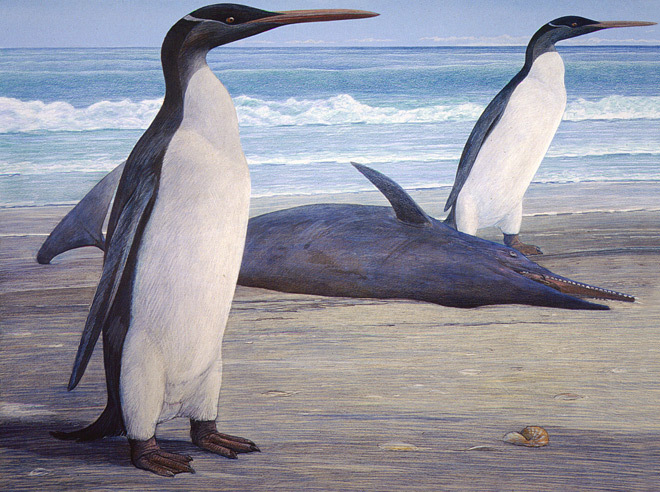Giant Prehistoric Penguins Unveiled

Scientists have constructed a model of an antediluvian penguin that stood almost 4 feet 6 inches tall and lived in New Zealand 25 million years ago, a new study says.
Known as Kairuku, a Maori word that means “diver who returns with food,” the penguin was recreated using two separate fossils and the skeleton of an existing king penguin. The bones were discovered 35 years ago by Dr Ewan Fordyce, a paleontologist from the University of Otago. Constructing this model is like putting all the pieces of a complicated puzzle together to determine the actual size and height of this giant prehistoric penguin.
The end result unveiled a penguin that would have been the biggest of the five species, who was living in New Zealand during the Oligocene era. New Zealand would have been the perfect habitat for this giant prehistoric penguin as access to a plentiful supply of food would have existed during that prehistoric time period.
Dan Ksepka, an avian paleontologist from North Carolina State University, was keenly inspired by the bones and its unusual shape of the body. “Kairuku was an elegant bird by penguin standards, with a slender body and long flippers, but short, thick legs and feet,” said Ksepka in a press release. “If we had done a reconstruction by extrapolating from the length of its flippers, it would have stood over six-feet tall. In reality, Kairuku was around four feet-and-two-inches tall or so.” He further added the species that were discovered, gives him an entire picture of these gigantic penguins as a whole and may help him to find out how large their range was during the Oligocene period.
According to Fordyce, the bird’s stretched out bill may have been helpful, so that it can easily catch its target and its huge body probably helped it swim vast distances and dive deeper than today’s penguins. The large size of this prehistoric penguin must have given this animal an edge especially in gathering food during prehistoric times. However, being large can also be a serious drawback as it might have fallen victim to other animals which might have targeted it due to its large size and body mass.
From Fordyce’ point of view, there were several reasons behind the extinction of these gigantic penguins such as climatic change, the influx of new predators or maybe increased competition for food from seals and other birds. It looks like further study will be required to understand how this giant prehistoric penguin lived and what types of food it survived on.




